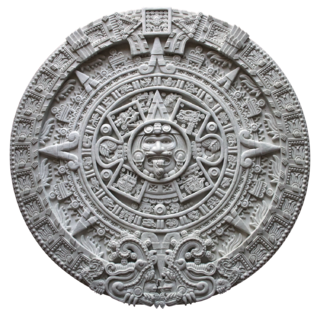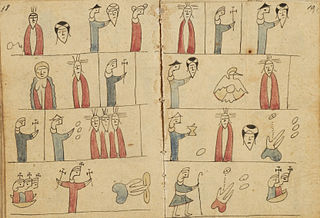This article does not cite any sources .(September 2014) (Learn how and when to remove this template message) |
In ethnohistory, a lienzo (Spanish for "canvas") is a sheet of cloth painted with indigenous Mesoamerican pictorial writing.
This article does not cite any sources .(September 2014) (Learn how and when to remove this template message) |
In ethnohistory, a lienzo (Spanish for "canvas") is a sheet of cloth painted with indigenous Mesoamerican pictorial writing.
| This article related to indigenous Mesoamerican culture is a stub. You can help Wikipedia by expanding it. |

The Olmecs were the earliest known major Mesoamerican civilization. Following a progressive development in Soconusco, they occupied the tropical lowlands of the modern-day Mexican states of Veracruz and Tabasco. It has been speculated that the Olmecs derived in part from the neighboring Mokaya or Mixe–Zoque cultures.

The Mesoamerican ballgame was a sport with ritual associations played since at least 1650 BCE by the pre-Columbian people of Ancient Mesoamerica. The sport had different versions in different places during the millennia, and a newer more modern version of the game, ulama, is still played in a few places by the indigenous population.

Mesoamerican chronology divides the history of prehispanic Mesoamerica into several periods: the Paleo-Indian, the Archaic, the Preclassic or Formative (2500 BCE–250 CE), the Classic (250–900 CE), and the Postclassic (900–1521 CE), Colonial (1521–1821), and Postcolonial (1821–present). The periodization of Mesoamerica is based on archaeological, ethnohistorical, and modern cultural anthropology research. The endeavor to create cultural histories of Mesoamerica dates to the early twentieth century, with ongoing work by archeologists, ethnohistorians, historians, and cultural anthropologists.

Mesoamerican calendars are the calendrical systems devised and used by the pre-Columbian cultures of Mesoamerica. Besides keeping time, Mesoamerican calendars were also used in religious observances and social rituals, such as for divination.

Mesoamerican languages are the languages indigenous to the Mesoamerican cultural area, which covers southern Mexico, all of Guatemala and Belize and parts of Honduras and El Salvador and Nicaragua. The area is characterized by extensive linguistic diversity containing several hundred different languages and seven major language families. Mesoamerica is also an area of high linguistic diffusion in that long-term interaction among speakers of different languages through several millennia has resulted in the convergence of certain linguistic traits across disparate language families. The Mesoamerican sprachbund is commonly referred to as the Mesoamerican Linguistic Area.
A Mayanist is a scholar specialising in research and study of the Mesoamerican pre-Columbian Maya civilization. This discipline should not be confused with Mayanism, a collection of New Age beliefs about the ancient Maya.
Mesoamerican creation myths are the collection of creation myths attributed to, or documented for, the various cultures and civilizations of pre-Columbian Mesoamerica and Mesoamerican literature.

The Isthmian script is a very early Mesoamerican writing system in use in the area of the Isthmus of Tehuantepec from perhaps 500 BCE to 500 CE, although there is disagreement on these dates. It is also called the La Mojarra script and the Epi-Olmec script.

Mesoamerica is a historical region and cultural area in North America. It extends from approximately central Mexico through Belize, Guatemala, El Salvador, Honduras, Nicaragua, and northern Costa Rica, and within this region pre-Columbian societies flourished before the Spanish colonization of the Americas. In the 16th century, European diseases like smallpox and measles caused the deaths of upwards of 90% of the indigenous people. It is one of five areas in the world where ancient civilization arose independently, and the second in the Americas along with Norte Chico (Caral-Supe) in present-day Peru, in the northern coastal region.

Mesoamerica, along with Mesopotamia and China, is among the three known places in the world where writing has thought to have developed independently. Mesoamerican scripts deciphered to date are a combination of logographic and syllabic values. They are often called hieroglyphs due to the iconic shapes of many of the glyphs, a pattern superficially similar to Egyptian hieroglyphs. Fifteen examples of distinct writing systems have been identified in pre-Columbian Mesoamerica, many from a single inscription. The limits of archaeological dating methods make it difficult to establish which was the earliest and hence the fore-bearer from which the others developed. The best documented and deciphered Mesoamerican writing system, and the most widely known, is the classic Maya script. An extensive Mesoamerican literature has been conserved partly in indigenous scripts and partly in the postconquest transcriptions in the Latin script.

The traditions of indigenous Mesoamerican literature extend back to the oldest-attested forms of early writing in the Mesoamerican region, which date from around the mid-1st millennium BCE. Many of the pre-Columbian cultures of Mesoamerica are known to have been literate societies, who produced a number of Mesoamerican writing systems of varying degrees of complexity and completeness. Mesoamerican writing systems arose independently from other writing systems in the world, and their development represents one of the very few such origins in the history of writing. The conquistadors brought their distinctive cultural creations, in the form of books, from Europe to the New World which further influenced native literature.

Mesoamerican architecture is the set of architectural traditions produced by pre-Columbian cultures and civilizations of Mesoamerica, traditions which are best known in the form of public, ceremonial and urban monumental buildings and structures. The distinctive features of Mesoamerican architecture encompass a number of different regional and historical styles, which however are significantly interrelated. These styles developed throughout the different phases of Mesoamerican history as a result of the intensive cultural exchange between the different cultures of the Mesoamerican culture area through thousands of years. Mesoamerican architecture is mostly noted for its pyramids, which are the largest such structures outside of Ancient Egypt.

The Cascajal Block is a tablet-sized writing slab in Mexico, made of serpentinite, which has been dated to the early first millennium BCE, incised with hitherto unknown characters that may represent the earliest writing system in the New World. Archaeologist Stephen D. Houston of Brown University said that this discovery helps to "link the Olmec civilization to literacy, document an unsuspected writing system, and reveal a new complexity to [the Olmec] civilization."

Testerian is a pictorial writing system that was used until the 19th century to teach Christian doctrine to the indigenous peoples of Mexico, who were unfamiliar with alphabetic writing systems. Its invention is attributed to Jacobo de Testera, a Franciscan who arrived in Mexico in 1529.
An undeciphered writing system is a written form of language that is not currently understood.

Mixtec writing originated as a logographic writing system during the Post-Classic period in Mesoamerican history. Records of genealogy, historic events, and myths are found in the pre-Columbian Mixtec codices. The arrival of Europeans in 1520 AD caused changes in form, style, and the function of the Mixtec writings. Today these codices and other Mixtec writings are used as a source of ethnographic, linguistic, and historical information for scholars, and help to preserve the identity of the Mixtec people as migration and globalization introduce new cultural influences.

San Andrés is an Olmec archaeological site in the present-day Mexican state of Tabasco. Located 5 km northeast of the Olmec ceremonial center of La Venta in the Grijalva river delta section of the Tabasco Coastal Plain, San Andrés is considered one of its elite satellite communities, with evidence of elite residences and other elite activities. Several important archaeological finds have been made at San Andrés, including the oldest evidence of the domesticated sunflower, insight into Olmec feasting rituals, didactic miniatures, and possible evidence of an Olmec writing system.

In art history, speech scroll is an illustrative device denoting speech, song, or, in rarer cases, other types of sound.
Frances Esther Karttunen, also known as Frances Ruley Karttunen, is an American academic linguist, historian and author. She received her BA in 1964 from Harvard and her PhD in 1970 from Indiana University. In her linguistics career Karttunen has specialised in the study of Mesoamerican languages such as Mayan but in particular Nahuatl, on which topic she has authored seven books and numerous academic papers. She has also written about endangered languages, linguistic diversity and language translation. Early in her career Karttunen also produced several studies of Finnish phonology and syntax.
Mesoamerican religion is a group of indigenous religions of Mesoamerica that were prevalent in the pre-Columbian era. Two of the most widely known examples of Mesoamerican religion are the Aztec religion and the Mayan religion.